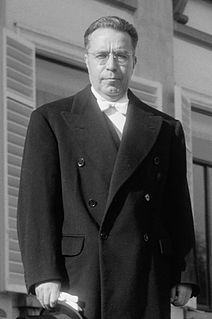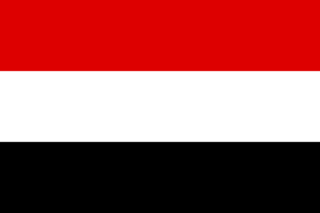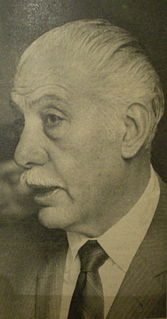
The Revolutionary Nationalist Movement is a Bolivian political party and the leading force behind the Bolivian National Revolution. It influenced much of the country's history since 1941.

Ángel Víctor Paz Estenssoro was a Bolivian politician who served as President of Bolivia from 1952 to 1956, 1960 to 1964 and 1985 to 1989. He ran for president eight times and was victorious in 1951, 1960, 1964 and 1985. His 1951 victory was annulled by a military junta led by Hugo Ballivián, and his 1964 victory was interrupted by the 1964 Bolivian coup d'état.

Jaime Paz Zamora was President of Bolivia from August 6, 1989 to August 6, 1993. He also served as Vice-President between 1982 and 1984.

Nationalist Democratic Action is a right-wing political party in Bolivia led by Dr. Freddy Terrazas Salas. ADN was founded on March 23, 1979 by the military dictator Hugo Banzer after he stepped down from power. It later expanded to include the Revolutionary Left Party (PIR) and a faction of the Bolivian Socialist Falange (FSB). As leader of the ADN, Banzer ran in the 1979, 1980, 1985, 1989, 1993, and 1997 presidential elections. He obtained third place in 1979 and 1980, and won a plurality of the 1985 vote, but, since he did not attain the 50% necessary for direct election, Congress selected the chief executive. Its choice was the second-place finisher, Dr. Víctor Paz Estenssoro.

Juan Lechín Oquendo was a labor-union leader and head of the Federation of Bolivian Mine Workers (FSTMB) from 1944 to 1987 and the Bolivian Workers' Union (COB) from 1952 to 1987. He also served as Vice President of Bolivia between 1960 and 1964.

The Revolutionary Party of the Nationalist Left was a left-wing political party in Bolivia. It was founded in 1963 by the labor leader Juan Lechín Oquendo and by Mario Torres Calleja and Edwin Moller in lesser roles. The PRIN seceded from the Revolutionary Nationalist Movement (MNR) in protest against Víctor Paz Estenssoro's decision to seek a third elected term as president in 1964, rather than permit then Vice-President Juan Lechín to have the MNR's presidential nomination.

The Bolivian Socialist Falange is a Bolivian political party established in 1937. Despite its leftist-sounding name, it was a far-right party drawing inspiration from fascism. It was the country's second-largest party between approximately 1954 and 1974. After that, its followers have tended to gravitate toward the government endorsed military candidacy of General Juan Pereda (1978) and, especially, toward the ADN party of former dictator Hugo Banzer. Its current status is unclear.
The history of Bolivia since 1982 begins with the restorations of democracy after the rule of the military junta of 1982. Evo Morales has held the presidency since 2006. A new constitution was enacted in 2009. Bolivia's population has roughly doubled over this period, from 5 million in 1980 to 10 million as of 2012.

General elections were held in Bolivia on 1 June 1997. As no candidate for the presidency received over 50% of the vote, the National Congress was required to elect a President on 4 August. Hugo Banzer of Nationalist Democratic Action (ADN) was subsequently elected. Whilst the ADN emerged as the largest party in Congress, it failed to win a majority of seats, and formed a coalition government with the Revolutionary Left Movement, Conscience of Fatherland and the Civic Solidarity Union.

General elections were held in Bolivia on 7 May 1989. As no candidate for the presidency received over 50% of the vote, the National Congress was required to elect a President on 6 August. Although the Revolutionary Nationalist Movement had received the most votes, its candidate for President Gonzalo Sánchez de Lozada was defeated by Jaime Paz Zamora of the Revolutionary Left Movement (MIR) in the Congressional vote, despite the MIR only finishing third in the public vote.

General elections were held in Bolivia on 31 May 1964. Víctor Paz Estenssoro of the Revolutionary Nationalist Movement (MNR) was the only candidate for president, and was re-elected with 98% of the vote. The MNR retained its large majority in Congress.

General elections were held in Bolivia on 6 May 1951. Víctor Paz Estenssoro of the opposition Revolutionary Nationalist Movement (MNR) received the most votes in the presidential election, but as he did not obtain an absolute majority, the National Congress was constitutionally obliged to elect a President on 6 August from the three candidates who received the most public votes. However, on 16 May a military junta assumed responsibility for the Government with Brigadier General Hugo Ballivián as President.
The Republican Socialist Unity Party was a political party founded on 10 November, 1946 in Bolivia as the fusion of the Republican Socialist Party, the Genuine Republican Party, the United Socialist Party, and the Independent Socialist Party.
The Authentic Revolutionary Party was a political party in Bolivia.
The Popular Christian Movement was a political party in Bolivia, de facto controlled by the military junta.
The Tupac Katari Revolutionary Movement is a left-wing political party in Bolivia.
The Revolutionary Nationalist Movement–Julio was a pro-military political party in Bolivia.












